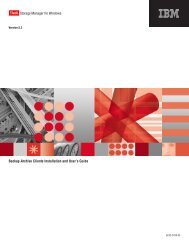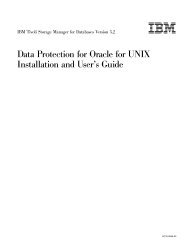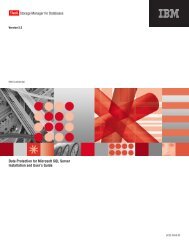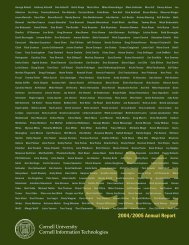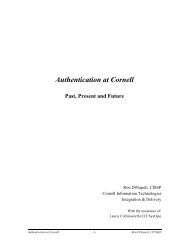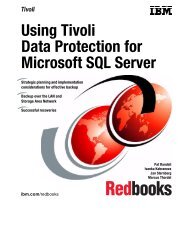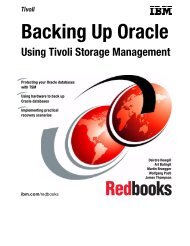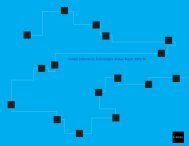Installation and User's Guide - Services and Support
Installation and User's Guide - Services and Support
Installation and User's Guide - Services and Support
Create successful ePaper yourself
Turn your PDF publications into a flip-book with our unique Google optimized e-Paper software.
IBM Confidentiallogfilename variable can include a fully-qualified path. However, if no pathis specified, the log file is written to the Data Protection for Exchangeinstallation directory.If the logfilename variable includes spaces, the entire /logfile parameterentry must be placed in double quotes. For example:/LOGFile="c:\Program Files\mytdpexchange.log"If the /logfile parameter is not specified, log records are written to thedefault log file, tdpexc.log.The /logfile parameter cannot be turned off. You always get logging.When using multiple simultaneous instances of Data Protection forExchange to perform operations, use the /logfile parameter to specify adifferent log file for each instance used. This directs logging for eachinstance to a different log file <strong>and</strong> prevents interspersed log file records.Failure to specify a different log file for each instance can result inunreadable log files./LOGPrune=numdays|NoUse the /logprune parameter to disable log pruning or to explicitly requesta prune of the log for one comm<strong>and</strong> run. By default, log pruning isenabled <strong>and</strong> performed once per day. The numdays variable represents thenumber of days to save log entries. By default, 60 days of log entries aresaved in the prune process. You can use the Data Protection for ExchangeGUI or the set comm<strong>and</strong> to change the defaults so that log pruning isdisabled, or so that more or less days of log entries are saved. Thecomm<strong>and</strong> line user may use the /logprune parameter to override thesedefaults for one comm<strong>and</strong> run. Note that when the value of the /logprunevariable numdays is a number in the range 0 to 9999, a prune is performedeven if one has already been performed for the day.Changes to the value of the timeformat or dateformat parameter can resultin an undesired pruning of the Data Protection for Exchange log file. If youare running a comm<strong>and</strong> that may prune the log file <strong>and</strong> the value of thetimeformat or dateformat parameter has changed, perform one of thefollowing to prevent undesired pruning of the log file:v Make a copy of the existing log file.v Specify a new log file with the /logfile parameter or logfile setting./MOUNTWait=Yes|NoIf the Tivoli Storage Manager server is configured to store the backup dataon removable media (such as tapes), then it is possible that the TivoliStorage Manager server might indicate to Data Protection for Exchangethat it is waiting for a required storage volume to be mounted. If thatoccurs, this parameter allows you to specify whether Data Protection forExchange should wait for the media mount or stop the current operation.You can specify:Yes Wait for tape mounts. This is the default.No Do not wait for tape mounts./OFFLOADSpecify this parameter to perform the integrity check <strong>and</strong> backup of files toTivoli Storage Manager on the machine specified by theremotedsmagentnode instead of the local machine. This parameter is80 Storage Manager for Mail 5.5: Data Protection for Microsoft Exchange Server <strong>Installation</strong> <strong>and</strong> User’s <strong>Guide</strong>



